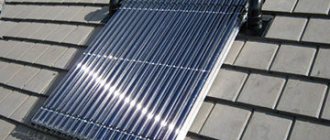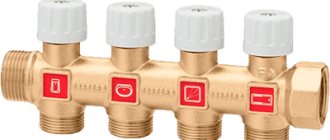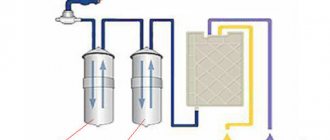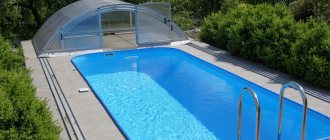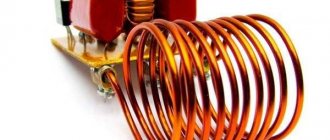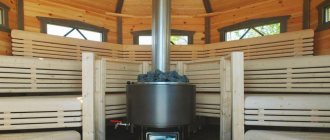A solar hot water collector is a modern and environmentally friendly way to generate heat from renewable energy sources. These are well-developed technologies that can significantly save the cost of operating a home. Below we will show what a solar battery for water is and what the principle of its operation is, we will talk about their types, as well as installation capabilities.
Operating principle of solar collectors
The operating principle of solar collectors is relatively simple.
Absorber
The first element that “captures” the sun’s rays is the collector, or more precisely, the absorber installed in it.
The device absorbs radiation and converts it into heat. The performance of the system depends mainly on the type of absorber.
Batteries equipped with the following types of absorbers or absorbers are often used:
- Normal - we recognize it by its characteristic black color. This type of absorber is not the most efficient and does not have very good feedback. It can absorb up to 80% of sunlight.
- Selective is a much better quality device that guarantees higher efficiency. Effectively receives rays, its efficiency can reach 95%.
Coolant
The absorber then heats the coolant flowing through the radiators or panels. Most often this is ordinary water, which can be used from spring to late autumn. In winter, the coolant can only be non-freezing liquid, which protects the entire system from possible damage.
The coolant operates in a closed system and, when heated, enters the tank. In the tank it gives off its heat to the water.
The cooled coolant passes through the absorber again and is heated again by sunlight.
Free heat in winter: myth or reality?
Vacuum solar systems, which have the highest efficiency, allow you to use hot water and heat all year round without spending the family budget on it. In the cold season, if the installation’s power is not enough to fully meet the need for hot water, such a system comes to the aid of the ability to heat water in tanks using heating elements. However, even in this case, the use of a solar system provides significant cost savings. Purchasing a quality installation is an excellent investment in your own future. The main thing is to correctly calculate the power and take into account the features when installing the system, knowing how the solar collector works in winter. Installations of other types (for example, fairly common flat panels), being more budget options, do not provide normal heat supply in cold weather. Using a homemade solar collector in winter is especially deceptive. Its power is not enough to work on cloudy days, not to mention freezing temperatures. The lack of vacuum (in contrast to high-quality factory installations) causes significant heat loss, reducing the efficiency of such a device in winter. At subzero temperatures, the water used as a coolant freezes in homemade collectors, making further use of the installation impossible. A self-made solar collector in winter provides low efficiency even when antifreeze is used instead of water. You can study the behavior of such an installation over a certain time by examining the solar collector on video in winter. Such a tool allows you to accurately understand how quickly snow melts from the solar system, calculate the number of days per season when the operation of the collector is practically impossible due to precipitation, which, in combination with a study of temperature fluctuations, will allow you to evaluate the efficiency and possibility of use in the cold season. Thus, operating a solar power plant in winter allows you to reduce the load on the heating system, reduce the consumption of gas, electricity and other energy sources, and makes it possible to heat the room and use hot water without significant costs for utility bills. A solar collector in winter is an economical and environmentally friendly means of heating!
Solar collectors – price
Unfortunately, solar panels are still a fairly expensive investment. The cost of the system and its installation depends on the complexity of the design. The minimum cost of a collector for the warm season with a 100 liter tank can be about 35,000 rubles. A year-round water heater with a 200 liter tank will cost about 80,000 rubles. This is the price of the kit only, excluding installation costs.
More advanced systems with selective absorbers and vacuum manifolds may cost more. Each expansion of the system's functionality and integration capabilities with other water supply and heating systems will increase costs. The upper price limit is difficult to determine.
Price overview
In addition to the world name, the cost of the heater can be influenced by:
- build quality;
- absorber and housing material;
- thickness and installation option of insulation;
- glass thickness, etc.;
Since there are many design differences that can affect the cost of equipment, prices fluctuate over a wide range. For example, a Russian-made manifold will cost around 21 thousand rubles. (Sokol-Effect), vacuum manifold 30HP – $795 (China), water heater VFK 150V – 690 euros (Vaillant, Germany), Solar 7000TF – 875 euros (Bosch, Germany).
German manufacturers include original fasteners in the kit, which are often made of stainless steel or aluminum, and this also affects the price. The final cost will include payment for installation work, purchase of necessary consumables and auxiliary materials.
Main types of collectors
In the store offers we will find several different panels that differ in structure, performance, installation method and purchase costs.
The most commonly used:
Flat-plate collectors - they account for about 70% of devices installed in homes. Their design is simple and the purchase price is affordable.
This type of panel works well in strong sunlight, but is not very effective at receiving diffuse rays. Their big disadvantage is the high heat consumption at low temperatures. Therefore, flat panels work best in the summer.
Vacuum Tube Collectors – These work on the same principle as flat panels. Nevertheless, the absorber in them is additionally surrounded by vacuum.
Therefore, the efficiency of the device does not depend so much on the outside temperature. The vacuum collector effectively heats water both in summer and in cloudless winter. The heat is absorbed by the absorber and almost completely used to heat water. As a result, the panel is more efficient and can heat more water.
Vacuum tube collectors with a heat pipe - this type of panel is equipped with special tubes filled with liquid. The intermediate fluid is at the bottom of the pipe.
As a result, solar panels can effectively cope with low temperatures and little sunlight. Unfortunately, this type has a very high price. The devices have good reviews, but the high cost still makes them a rare type of battery in our homes.
Device and scope of application in everyday life
Today the following types of solar power plants are used: flat-plate and vacuum
Flat plate
These are the simplest and cheapest devices. They consist of a plate that catches solar radiation (absorber), a transparent coating and thermal insulation covering the lower surface. Black paint or a special coating, such as titanium oxide or black nickel, is applied to the surface of the plate facing the sun. It's called selective. The most effective absorbers are those made of copper.
The light-transmitting coating is made of a special profile polycarbonate sheet (with corrugation) or tempered glass, almost completely free of metal impurities.
All gaps between the collector body and the transparent cover are sealed, which helps reduce heat loss due to convection.
Flat plate collector
In air collectors, the air used as a coolant flows directly through the absorber - on one or both sides. In devices focused on the use of a coolant fluid (water, oil or antifreeze), copper or aluminum tubes into which this coolant is supplied can be attached to the absorber.
If the heat accumulated by a flat plate collector is not removed, it can heat the water to a temperature of 190 - 210 degrees.
To increase the efficiency of such installations, coatings made of special materials are used that do not emit heat in the form of infrared waves.
Vacuum
The role of an absorber in such a collector is played by the surface of the tube through which the coolant flows. At the same time, it itself is enclosed in a round transparent casing, from which the air is pumped out. Thus, each coolant tube is surrounded, like a thermos flask, by vacuum.
A vacuum collector is more expensive, but it is more efficient: with its help, water can be heated to 250 - 300 degrees.
Vacuum manifolds
The performance of a vacuum collector can be significantly increased by using parabolic cylindrical reflectors. These are oblong elements with a concave mirror surface, which in cross section forms a parabola. Such reflectors are installed in the collector behind the tubes, focusing all unassimilated sunlight onto them.
An installation equipped with such elements can heat the coolant (oil is used) to a temperature of 300 - 390 degrees. To further increase the collector's performance, it is equipped with a sun tracking system.
Other system elements
In addition to the collector itself, the solar installation has a storage tank with water, to which the energy accumulated by the coolant is transferred using a built-in heat exchanger.
There are systems with both natural circulation of the coolant (the storage tank is installed above the collector) and with forced circulation - using a pump (the tank can be installed at any level).
Solar collectors in the heating system
Application
In everyday life, solar power plants are used for preparing hot water, including for baths, heating a swimming pool, or as an additional source of heat for a heating system. In industry, the scope of application of such systems is wider: they are used to build water desalination plants, steam generators (steam drives various machines) and even power plants.
Installation of a solar collector for water
Particular attention should be paid to the installation of the system, since this greatly affects the efficiency of water heating.
We can find panels that can be installed:
- on the roofs of houses,
- in the roofs,
- free-standing units.
There are a lot of installation options. However, you should stick to the basic principle that the panels should be placed in areas with high levels of light. All shaded areas are contraindicated; they reduce the effectiveness of such equipment.
Do-it-yourself installation of solar collectors on the roof of houses
Collectors are usually installed on the roofs of houses. This applies to all types of panels available on the market. The batteries can be installed on existing buildings.
Installing DIY solar panels is relatively simple. Simply install the panel brackets and connect the pipes to them.
Installing panels on roofs is not difficult, but a much better solution is to install them in the roof .
As a result, we will reduce heat loss and make the system more efficient. Only flat-plate collectors can be installed in the roof. This solution should be considered during the construction phase, since interfering with the existing roof will be quite expensive.
Solar collector on the balcony
An interesting solution is solar panels on the balcony and on the ground. This installation method provides great possibilities for adjusting the angle of inclination of the panels.
In this way, they can be optimally adapted to the incident sunlight. Solar panels also absorb rays reflected from the ground and from the building. This also leads to increased efficiency.
Free standing solar panels for water
It is worth noting that free-standing panels require well-insulated coolant pipes.
Insufficient thermal insulation can significantly reduce the efficiency of the entire collector.
Which installation method should I choose?
It all depends on the specifics of the building and the surrounding area. The solutions have various advantages and disadvantages, so you should consult the installation company about the installation method. It is worth remembering that one of the biggest problems with sewers is the deposition of pollutants. Even fine dust settling on the flat plates of the commutator can reduce its efficiency. Therefore, it is very important to ensure that batteries can be cleaned regularly.
Solar Water Heater Designs
Now that the idea of a solar water heater is clear, let’s try to design it ourselves. The truck's tank does not need modification. Black, with a neck on top for filling with water, and often an outlet on the bottom. All that remains is to place it on the shower, fill it with water, and wait for the Sun to do the work. Of course, the water will be cool in the morning; you can wash in the afternoon. The advantage of the device is its simplicity. You will have to clean the tank of gasoline and oil so as not to go bald. Not everyone can afford to buy a factory-type solar water heater.
It is necessary to fill the tank with hot water and detergent, let it settle, and drain. Repeat the process, rinse with clean water, achieving crystal clear drainage. Most of the crap will be removed from the tank. In the future, you can put the unit in the sun for a week, drain the water, and do not wash it. After the procedure, the tank can be used for showering.
As for the question of where to get it, today electronic message boards are full of offers to sell used containers. Modern ones are often made of aluminum, while older ones are made of steel. The issue price is 2000 rubles. We consider the use of complex structures inappropriate. If you have steel (not cast iron) radiators like the one shown in the picture lying around, try to assemble a standing device, only for the summer. We will not use glass or gas tanks; we will need black paint and pipes. We believe that the design should contain a container for hot water located in the house of a sufficiently large volume.
You will need a low-power flow pump with fitting dimensions for a standard pipeline. We offer to make homemade solar water heaters in the image and likeness of factory ones. Let's place on the roof slope series-connected radiators of at least three, painted black.
We paint the pipes of a homemade solar water heater in the same way. We insulate the home tank with liquid rubber. Forget polyurethane foam, no other sprayed thermal insulation comes to mind. There are four holes in the homemade solar water heater tank:
Three at the top:
- Water intake.
- Replenishing water supplies.
- Battery output.
Below, hot water from the batteries will enter the tank.
Convection currents in the tank will take on a natural character. Warm water enters from below and begins to rise upward. It is necessary to install a horizontal reflector plate opposite the entrance to prevent the formation of a vertical flow above the entrance. We install the flow pump on the hood near the corresponding upper hole. For the location of the radiators of a homemade solar water heater, we choose the southern slope of the roof. It can also be a horizontal roof. The bottom of the radiators is finished with reflective insulation like Penofol. Only the sunny side can be painted with black paint.
The structure is ready. It is not advisable to cover the assembly with glass; it is advisable to protect it from the wind. The winnings will be received. The population will benefit from solar water heaters for their summer cottages. At night we turn off the pump and remove the structure from the roof for the winter. Factory-made solar water heaters for heating will give you a hundred points head start in efficiency, but we will crush you with price. A cheap factory manifold costs 15,000 rubles. If you want to spend money, we’ll look into a heat pump for heating for a substantial sum.
We will leave solar-powered water heaters to Germany and similar countries. In Europe, there is a government support program for energy-saving technologies; electricity can be pumped back into the grid (no joke). We will assemble a solar water heater for a swimming pool using the technology discussed above. Radiators can be laid out on a platform; the tank will be an artificial reservoir; do not forget to disinfect the water. It's a good idea to use mirrors lined with aluminum foil. You can stick the film on thin plywood panels and collect energy in the right place. It will turn out cheap and cheerful. There will be protection against the wind, and the radiators will heat up faster. The installation location is north of the collectors.
Now readers know how to make a solar water heater.
Is it profitable to install solar panels?
Today, this is a fashionable and environmentally friendly solution that is receiving good reviews. However, they are still expensive to purchase and install. Standard manifolds can supply about 60% of annual hot water demand. The cost of installing the system can be recouped in a few years. After exactly how long, you can calculate it yourself by collecting your bills for heating hot water for the year. These amounts will vary depending on the method of heating the water, the cost of electricity, the amount of water consumed and other factors.
DIY Solar Installation Options
The peculiarity of self-built solar water heaters is that almost all devices have the same design of a thermally insulated box. Often the frame is assembled from lumber and covered with mineral wool and heat-reflecting film. As for the absorber, metal and plastic pipes are used for its production, as well as ready-made components from unnecessary household equipment.
From a garden hose
A garden hose folded like a snail or a PVC water pipe has a large surface area, which makes it possible to use such a circuit as a water heater for the needs of a summer shower, kitchen or swimming pool heating. Of course, for these purposes it is better to take black materials and be sure to use a storage container, otherwise the absorber will overheat during the peak summer heat.
A flat manifold made from a garden hose is the simplest way to heat water in a pool.
From an old refrigerator condenser
The external heat exchanger of a used refrigerator or freezer is a ready-made solar collector absorber. All that remains to be done is to equip it with a heat-absorbing sheet and install it in the case. Of course, the performance of such a system will be small, but in the warm season, a water heater made from refrigeration equipment parts will cover the hot water needs of a small country house or cottage.
The heat exchanger of an old refrigerator is an almost ready-made absorber for a small solar heater
From a flat radiator of a heating system
Making a solar collector from a steel radiator does not even require the installation of an absorbent plate. It is enough to cover the device with black heat-resistant paint and mount it in a sealed casing. The productivity of one installation is more than enough for a hot water supply system. If you make several water heaters, you can save on heating your home in cold, sunny weather. By the way, a solar installation assembled from radiators will heat utility rooms, a garage or a greenhouse.
A steel heating radiator will serve as the basis for building an environmentally friendly water heater
Made from polypropylene or polyethylene pipes
Pipes made of metal-plastic, polyethylene and polypropylene, as well as fittings and devices for their installation, allow you to build solar system circuits of any size and configuration. Such installations have good performance and are used for heating rooms and obtaining hot water for household needs (kitchen, bathroom, etc.).
The advantage of a solar collector made of plastic pipes is its low cost and ease of installation.
From copper tubes
Absorbers built from copper plates and tubes have the highest heat transfer, therefore they are successfully used for heating the coolant of heating systems and in hot water supply. The disadvantages of copper collectors include high labor costs and the cost of materials.
The use of copper pipes and plates for the manufacture of the absorber guarantees high performance of the solar installation
Collector Stanilova
Engineer Stanislav Stanilov presented the world with the most versatile solar collector design. The main idea of using the device he developed is to obtain thermal energy by creating a greenhouse effect inside the collector.
Collector design
The design of this collector is very simple. Essentially, this is a solar collector made of steel pipes welded into a radiator, which is placed in a wooden container protected by thermal insulation. Mineral wool, polystyrene foam, and polystyrene can be used as thermal insulation materials.
A galvanized metal sheet is placed at the bottom of the box, on which the radiator is mounted. Both the sheet and the radiator are painted black, and the box itself is covered with white paint. Of course, the container is covered with a glass lid, which is well sealed.
Materials and parts for manufacturing
To build such a homemade solar collector for heating a house you will need:
- glass that will serve as a lid. Its size will depend on the dimensions of the box. For good efficiency, it is better to select glass measuring 1700 mm by 700 mm;
- glass frame - you can weld it yourself from corners or put together from wooden planks;
- board for the box. Here you can use any boards, even from dismantling old furniture or plank floors;
- rental corner;
- coupling;
- pipes for radiator assembly;
- clamps for attaching the radiator;
- galvanized iron sheet;
- radiator inlet and outlet pipes;
- tank with a volume of 200−300 liters;
- aqua chamber;
- thermal insulation (sheets of polystyrene foam, expanded polystyrene, mineral wool, ecowool).
Stages of work
Stages of making a Stanilov collector with your own hands:
- A container is made from boards, the bottom of which is reinforced with beams.
- A heat insulator is placed at the bottom. The base must be especially carefully insulated to avoid heat leakage from the heat exchanger.
- Afterwards, a galvanized plate is placed at the bottom of the box and a radiator is installed, which is welded from pipes, and secured with steel clamps.
- The radiator and the sheet underneath are painted black, and the box is painted white or silver.
- The water tank should be installed under the collector in a warm room. Between the water tank and the collector you need to install thermal insulation to keep the pipes warm. The tank can be placed in a large barrel into which expanded clay, sand, sawdust, etc. can be poured. and thus insulate.
- An aqua chamber must be installed above the tank to create pressure in the network.
- Do-it-yourself solar collector installation should be done on the south side of the roof.
- After all the elements of the system are ready and installed, you need to connect them into a network with half-inch pipes, which must be well insulated in order to reduce heat loss.
- It would be a good idea to build a controller for the solar collector with your own hands, since factory devices do not last long.
Installation
Since the equipment is powered by solar energy, the heater will be installed outdoors.
Installation is recommended to be carried out on the roofs of buildings, on balconies or other architectural protrusions. The water heater screen should be directed south. The installation is carried out at a certain angle to the horizon, which is equivalent to the geographic latitude of the area.
The water heater constantly absorbs energy and for obvious reasons the energy source cannot be turned off, therefore, in the case of low water consumption, the stagnation temperature can reach up to 300°C.
For this reason, the use of plastic and steel pipes with zinc coating is not allowed. Pipelines made of copper or stainless steel will be optimal for operation.
The hot circuit of a solar water heater must be insulated to avoid burns and fires. The operating temperature of the equipment should be taken into account when choosing thermal insulation and fasteners.
Manufacturers of solar water heaters indicate the exact stagnation temperature on the body of their products. The collector panels should be located in an open space so that there is open access to sunlight. It is necessary to exclude the presence of possible obstacles.
Most often, the angle of inclination of the collector will be the slope of the roof slope. In order to bring the water heater operating efficiency closer to maximum, it is better to follow the recommendations and use a special rack on which the collector will be mounted.
Those. The key to proper and efficient operation of the equipment are just a few rules:
- direction south;
- correct angle of inclination;
- unhindered access to sunlight;
Incorrect installation will reduce the quality of the water heater, and the investment will not be justified. The type of heater can also play a role in how it is installed. During installation, take into account the type of equipment used.
The following systems are distinguished:
Passive
It implies the absorption and accumulation of energy that occurs naturally. Solar energy enters the heating object without controlling this process, i.e. There are no mechanisms or control elements. This is a simple system that does not require any special costs. However, the disadvantages are that the water heater operates unevenly and not at full capacity.
The most obvious example is a darkened tank, which is located above the outdoor shower. Single-circuit systems that use the natural circulation process operate in this passive mode. For full operation of the system, the receiving tank is placed above the collector, but this installation method is not always convenient. The issue can be resolved using another way of operating the system.
Active
Free from the disadvantages of a passive system. Its operation is based on the fact that the sun's rays, thanks to special devices, are converted into thermal energy, which is systematically transferred to the heating tank and the consumer. The operation of such a heater is achieved thanks to forced circulation, which can be maintained in single- and double-circuit systems. Also used and additionally installed are motors that rotate panels and pumps, measuring equipment, as well as devices for monitoring and controlling the operation of the system.

